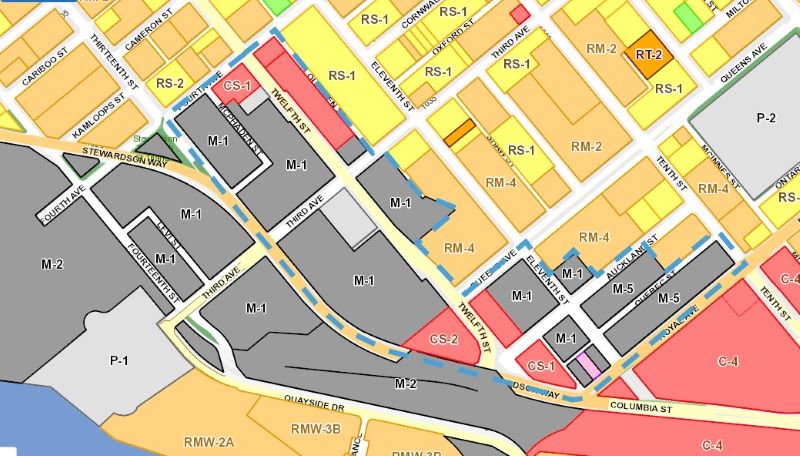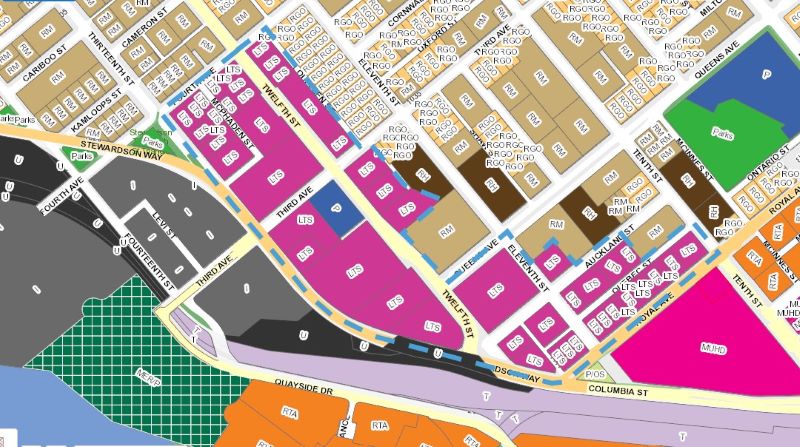There was an interesting discussion at Council Workshop on Monday that is worth unpacking a bit. I don’t usually write up Workshop reports here, because these are not typical Council meetings. They tend to be more free-ranging conversations Council has about items that are preliminary or half-cooked; more of a check in and request for direction from Council on an ongoing initiative than final decision points. We talked about spending on Canucks viewing parties, about the Liquid Waste Management Plan, and about next steps on Vision Zero, but the most interesting item was staff checking in with Council on the Lower 12th Special Study Area.


Lower 12th is a (mostly) grey spot on the City’s zoning map, and an equally distinct purple spot in our Official Community Plan maps. It was an area identified during the 2017 Official Community Plan discussions as being unique, and requiring a unique approach. The current OCP updates (being driven by Provincial mandate) and some preliminary applications by developers interested in putting mixed-use residential development here are pushing staff to ask Council how they want to deal with this space.
The background here is that Council back in 2017 saw this space as needing to continue to be a job-generating space. One of the larger policy goals of our OCP is to continue to develop job growth on pace with population growth (as we have managed to do over the last few years, despite the COVID blip). Staff and Council identified this area as being one of the last parts of the “mainland” where job creation is the main land-use driver. It is also unique in the downtwon area in that there are relatively large lots, it is generally flat, and the transportation connections are robust, including being a short walk from a SkyTrian station. This all means there is opportunity here.
Much of the land there is zoned as light industrial and commercial, and with no OCP designation (except “special study area”), significant development would require OCP amendment and rezoning. Although valuable commercial businesses, used car lots are not likely the “highest and best use” of properties in the centre of a dense urban city only a few hundred metres from a SkyTrain station. There is pent up value here that developers would love to release, and the most value in the region right now is in housing.
Up to now, much of the discussion of this area has been how to maintain ultra-light industrial and commercial space, maker space or light manufacturing while adding housing to help finance the redevelopment of an under-perfomring area. But the demands in New West in 2025 are different than those in 2017, and Council is more interested in learning how new modes of retail and commercial land use can be supported. Council also recognizes the increased need for green space in the Downtown and Brow neighbourhoods, need for school space and potentially other institutional spaces, and even need for expanded community amenity space for everything from a new Firehall to city administrative space and community centre space.
With all of this in mind, I opened the discussion at Council asking that we take a bit of a step back, and Council unanimously agreed. Staff is going to do more work on the Parks and Recreation Comprehensive Plan, on our Economic Development plans (Retail Strategy, Employment Strategy), and bring Council some more options around how this unique part of the City might develop differently. That may, or may not, include significant residential density to support redevelopment, and this is where I think Council still needs to give some clear direction in the next little while. But we need to give that direction with a fuller understanding of the land economics and potential for this unique area.
We are not a City that has traditionally said “no” to housing, and have taken seriously our responsibility to meet our Housing Target Orders, and meet our regional commitment to housing need. Our upcoming OCP update will address our 20-year housing need as required by regulation. That said, it is not obvious that we need housing in this location to meet those commitments or obligations, and we certainly don’t need housing at the density envisioned by the early catalyst projects in this area. I don’t think we should preclude, however, the opportunity to leverage truly affordable (non-market supportive or transitional) housing in this area if senior government partners are ready to fund it.
Everyone recognizes we also schools, we need green space, we need institutional, community, and creative space to support the livability of our community, and this “grey area” is a place that may provide unique opportunity to fit more of those needs in one of the denser parts of the City. It was a great conversation at Council, and I’m happy we were all able to come to a pretty clear consensus on this.
More to come!